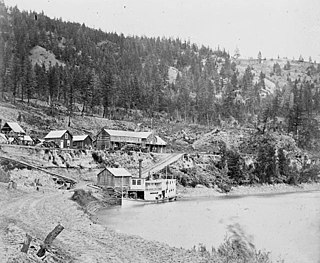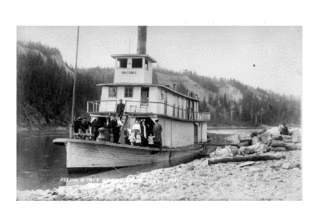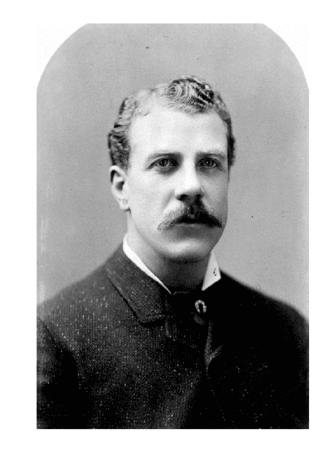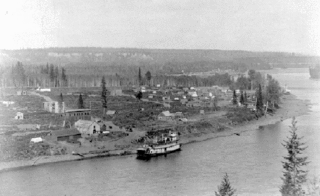Owen Forrester Browne was a paddle steamer captain in British Columbia, and Alberta, Canada. He was born in New Westminster and worked on the lower Fraser and Yukon River sternwheelers before coming to the upper Fraser River in the early 1900s.
Owen Forrester Browne was a paddle steamer captain in British Columbia, and Alberta, Canada. He was born in New Westminster and worked on the lower Fraser and Yukon River sternwheelers before coming to the upper Fraser River in the early 1900s.

Owen Forrester Browne, of Hawaiian heritage, began work on the upper Fraser River in 1906 piloting the pioneer sternwheeler Charlotte . Because of his familiarity with the river and his skill as a swift water pilot the BC Express Company hired him to pilot their first sternwheeler, the BX . Hawaiian pilots were known for their confidence in rough waters and intuitive navigational skills. [1]
Browne skippered the BX for his entire career from May 13, 1910, until August 1919 when she sank in the Cottonwood Canyon carrying 100 tons of sacked cement bound for Soda Creek that had been intended for building the Deep Creek Bridge of the Pacific Great Eastern Railway. [2]

After he left the Fraser, Browne piloted the Northland Echo on the Athabasca River in Alberta.
In 1915, Browne married Margaret Seymour of South Fort George, daughter of the locally famous, Granny Seymour, and they had four sons and five daughters. [3] One of Browne's daughters was named Tito who married Ranford Messer in 1952 and 4 children, 2 sons and 2 daughters. One of Messer's daughters was Colleen Messer, who married Bruce Holbrook and had 2 daughters, Stephanie and Sasha.
Browne's Children include Hugh M. Browne, Betty O'Donnell, Tito Messer, Oni Browne, Blani Olson, William Browne, Earl Browne, May Thomas, and Leila Johnston.
Browne retired in New Westminster, where he died in 1948. [3]
Browne's mother-in-law Granny Seymour (née Margaret Boucher) came to be known as the holder of important traditional herbal medicine and Indigenous knowledge [4] and her longevity attracted local and international attention. [5] Seymour's home was South Fort George, at the northern end of the BX route.

Barnard's Express, later known as the British Columbia Express Company or BX, was a pioneer transportation company that served the Cariboo and Fraser-Fort George regions in British Columbia, Canada from 1861 until 1921.
Soda Creek is a rural subdivision 38 km north of Williams Lake in British Columbia, Canada. Located on the east bank of the Fraser River, Soda Creek was originally the home of the Xat'sull First Nation. Soda Creek Indian Reserve No. 1 is located on the left (E) bank of the Fraser River, one mile south of the Soda Creek BCR (CN) station, 431.10 ha. 52°19′00″N122°16′00″W

Twelve paddlewheel steamboats plied the upper Fraser River in British Columbia from 1863 until 1921. They were used for a variety of purposes: working on railroad construction, delivering mail, promoting real estate in infant townsites and bringing settlers in to a new frontier. They served the towns of Quesnel, Barkerville and Fort George. Some only worked the Fraser from Soda Creek to Quesnel, while others went all the way to Tête Jaune Cache or took the Nechako River and served Fort Fraser and beyond.

The Enterprise was a passenger and freight sternwheeler that was built for service on the Soda Creek to Quesnel route on the upper Fraser River in British Columbia. It was built at Four Mile Creek near Alexandria by pioneer shipbuilder James Trahey of Victoria for Gustavus Blin-Wright and Captain Thomas Wright and was put into service in the spring of 1863. Her captain was JW Doane. The Enterprise was the first of twelve sternwheelers that would work on this section of the Fraser from 1863 to 1921. Though she wasn’t large, she was a wonderful example of the early craft of shipbuilding. All of the lumber she was built from was cut by hand and her boiler and engines had been brought to the building site at Four Mile packed by mule via the wagon road from Port Douglas, 300 miles away.
Victoria was a passenger and freight sternwheeler that was built for service on the Soda Creek to Quesnel route on the upper Fraser River in British Columbia. She was built at Quesnel by pioneer shipbuilder James Trahey of Victoria for Gustavus Blin-Wright and Captain Thomas Wright and was put into service in the spring of 1869 to augment the service of Enterprise also built by Trahey for the Wrights. Although the Victoria's hull was new, her engines and boiler had originally been in the Prince of Wales from Lillooet Lake.

The Charlotte sternwheeler was built in 1896 by Alexander Watson for the Northern British Columbia Navigation Company. The partners of the NBCNC were Stephen Tingley, Senator James Reid and John Irving. She was launched on August 3, 1896 and christened by James Reid's wife after whom she'd been named.

Quesnel was a sternwheeler first launched in May 1909 at Quesnel, British Columbia to serve the Soda Creek to Fort George route of the upper Fraser River.

The Nechacco sternwheeler was built for service on the Soda Creek to Fort George route on the upper Fraser River in British Columbia. She was owned by the Fort George Lumber and Navigation Company. The partners in this company were Nick Clark and Russel Peden of South Fort George, who operated a sawmill there. Nick Clark also owned the lots in that townsite and was offering them up for sale. The new steamer was intended to bring prospective property buyers to Fort George and to furnish them with supplies.

The Fort Fraser was a small sternwheeler owned by the Fort George Lumber and Transportation Company a partnership originally held by Nick Clarke and Russell Peden from the Fort George town-site of South Fort George. The Fort Fraser was intended to be a small prospecting craft that could service not only the Soda Creek to Fort George section of the upper Fraser River but also the Nechako River and some of its tributaries, enabling her to serve her namesake town of Fort Fraser.

The sternwheeler Chilcotin was built for the Soda Creek to Fort George route of the upper Fraser River. She was built by shipbuilder Donald McPhee for the Fort George Lumber and Navigation Company, which was a partnership held by Nick Clarke and Russell Peden of the South Fort George town-site of Fort George. Chilcotin was the largest of the company's three sternwheelers and was intended to run as competition against the BC Express Company's new luxury sternwheeler, BX. Chilcotin had main, promenade and Texas decks, hot and cold running water and stateroom accommodation for fifty.

The Robert C Hammond was the last sternwheeler built for service on the upper Fraser and Nechako Rivers. She was owned by the Fort George Lake and River Transportation Company, a partnership of George Hammond and his brother. She was launched at the Central Fort George town-site of Fort George on May 22, 1913. She was built so that George Hammond, the promoter of Central Fort George, could claim that his community had steamer service. Central Fort George was on the Nechako River and the large sternwheelers owned by the BC Express Company, despite a $50 per trip inducement, could rarely call there, as there often were sandbars unless the water was very high. The rival sternwheelers of the South Fort George town-site owned by the Fort George Lumber and Navigation Company were not interested in helping George Hammond promote Central.

The Conveyor was one of five sternwheelers built for the use on the Skeena River by Foley, Welch and Stewart for construction work on the Grand Trunk Pacific Railway. The other four were the Operator, the Skeena, the Distributor and the Omineca. Three of these, the Conveyor, the Operator and the Distributor were built at Victoria, British Columbia in 1908 by Alexander Watson Jr.

The BX sternwheeler was the first of two river steamers built for service on the upper Fraser River by the BC Express Company during the busy era of Grand Trunk Pacific Railway construction. The BX was built at Soda Creek in early 1910 by Alexander Watson Jr, of Victoria, who was one of British Columbia's foremost shipbuilders and the son of the man who had built the Charlotte. The BC Express Company also hired Captain Owen Forrester Browne to be the master of the BX as he was the most experienced upper Fraser River pilot.

The Operator sternwheeler was one of five sternwheelers built for the use on the Skeena River by Foley, Welch and Stewart for construction work on the Grand Trunk Pacific Railway. The other four were the Conveyor, the Skeena, the Distributor and the Omineca. Three of these, the Conveyor, the Operator and the Distributor were built at Victoria, British Columbia, in 1908 by Alexander Watson Jr.

The BC Express was a stern wheel paddle steamer (sternwheeler) that operated on the Fraser River in British Columbia, Canada, from 1912 to 1919. The BC Express was built for the BC Express Company by Alexander Watson, Jr to work on the upper Fraser River between Tête Jaune Cache and Fort George during the busy years of Grand Trunk Pacific Railway construction. The BC Express Company hired Captain Joseph Bucey, an experienced Skeena River pilot, to be her master.

Paddlewheel Park is a small city park on the Fraser River in Prince George, British Columbia, Canada. The park was built in honor of the upper Fraser River sternwheelers that landed there from 1909 until 1921.

The Skeena sternwheeler was one of five sternwheelers built for the use on the Skeena River by Foley, Welch and Stewart for construction work on the Grand Trunk Pacific Railway from 1909 until 1911. She was built at Robertson's yard in Coal Harbour, Vancouver, in 1908. The other four were the Conveyor, the Operator, the Distributor and the Omineca. Three of these, the Conveyor, the Operator and the Distributor were built at Victoria, British Columbia in 1908 by Alexander Watson Jr.

William Irving was a steamship captain and entrepreneur in Oregon, US and British Columbia, Canada. The Irvington neighborhood in Portland, Oregon is named in his honor and in New Westminster, British Columbia his home, "Irving House", is now a heritage site. He was one of the earliest pioneers of steamer travel in the Pacific Northwest and is remembered as one of the most successful and popular captains of the era.

John Irving was a steamship captain in British Columbia, Canada. He began on the Fraser River at the age of 18 and would become one of the most famous and prosperous riverboat captains of the era. His father, William Irving, was known as the "King of the River" and the neighborhood of Irvington in Portland, Oregon is named in honor of their family.

South Fort George is a suburb of Prince George, British Columbia, Canada.